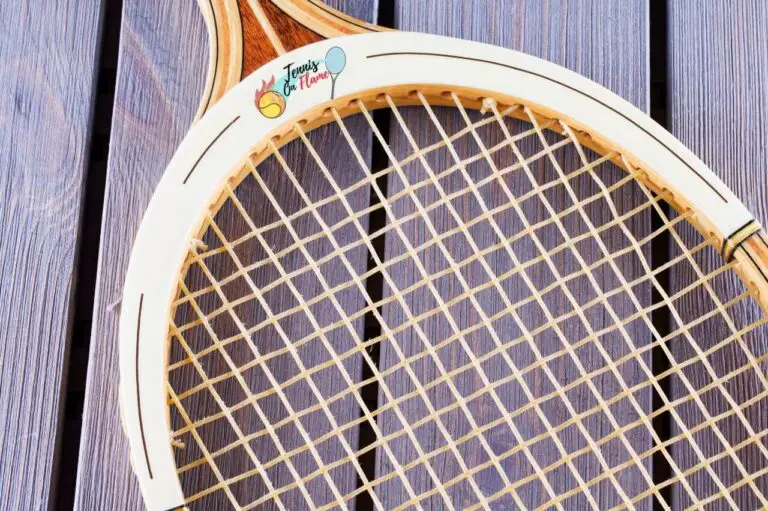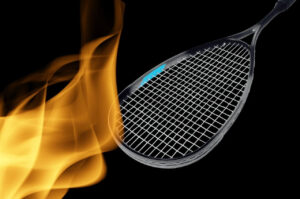It is hard to believe that tennis rackets were once made from wood, but it is true – so no wonder many of our readers wanted to know when did tennis rackets change from wood.
Wooden tennis rackets were common until the early 1970s when they were replaced by metal and graphite rackets.
So what happened? Why did tennis rackets change from wood?
In this article, we will explore the history of tennis rackets and discuss why wooden rackets are no longer found in the market today.
When Did Tennis Rackets Change from Wood and Why?
The first tennis rackets were made from wood and they were used until the early 1970s when metal and graphite rackets became popular.
Wooden tennis rackets are considered old-fashioned today and you will not find them in the market.
So what happened? Why did tennis rackets change from wood? Well, there are a few reasons why tennis rackets changed from wood:
First, metal and graphite rackets are more durable than wooden rackets and they can last longer.
Second, metal and graphite rackets provide more power and speed to the ball.
Third, metal and graphite rackets are lighter in weight and easier to handle.
Last, metal and graphite rackets are cheaper to manufacture than wooden ones.

What was the first Metal tennis racket?
The first metal tennis racket was introduced in 1967 by Wilson Sporting Goods Company called the “T-2000.”
The T-2000 featured a thin sheet of steel with holes punched through it and strung like a conventional racket. It became popular on the professional tennis circuit and was used by many top players, including Jimmy Connors.
When did Wilson start making tennis rackets?
The first Wilson tennis racket was made in 1914.
Today, they are known as one of the leading manufacturers of sporting goods equipment and have produced some of the most popular rackets used by professional players on tour.
They introduced their first metal-framed T2000 in 1967 which became a staple for many pros at that time including Jimmy Connors.
When did manufacturers stop making wooden tennis rackets?
Wooden tennis rackets were gradually phased out in the 1970s and they are no longer found in the market today.
By the year 1980, metal and graphite rackets had completely replaced wooden ones.
Why don’t manufacturers make wooden tennis rackets today?
Manufacturers stopped making wooden tennis rackets today because they are no longer popular or used.
Metal and graphite rackets are more durable, powerful, and easier to use than wooden ones.
They also provide a better playing experience for the user.
Do Wooden Tennis Rackets have any benefits?
Wooden tennis rackets do have some benefits over metal and graphite rackets.
First, a wooden tennis racket is more durable than a metal one and can last longer.
Second, it provides greater control over the ball when hitting it with power or spin.
Last, it can be repaired if broken by simply replacing the strings on top of each other rather than having to buy an entirely new racket as you would need to do with a metal one.
This means that wooden tennis rackets are more cost-effective in the long term than metal or graphite ones.
However, these benefits are no longer enough to outweigh the advantages of metal and graphite rackets and that is why most manufacturers stopped making wooden rackets.
What are the disadvantages of a wooden tennis racket?
There are some disadvantages to using a wooden tennis racket as well:
First, it’s heavy compared with other types of racquets such as metal or graphite ones (which makes them harder to use).
Second, they don’t provide as much power or speed to the ball as metal or graphite rackets.
Third, they are not as durable as metal or graphite rackets and may break after a few months of use.
Fourth, they are more expensive than other types of racquets on the market today.
Overall, wooden tennis rackets are not as popular or used today because they have many disadvantages over other types of racquets.
They do, however, have some benefits such as being more durable and providing greater control when hitting the ball with power or spin but these benefits don’t outweigh their disadvantages.
Do Wooden Tennis Rackets require a different technique?
Yes, using a wooden tennis racket does require a different technique than using metal or graphite rackets.
With a wooden racket, you need to generate more power when hitting the ball to make up for its lack of speed and power.
You also need to be more precise with your shots as there is less margin for error due to the weight of a wooden racket.
How old is the oldest wooden tennis racket?
The oldest known and still-working wooden tennis racket can be found in England at Wimbledon Lawn Tennis Museum which was made in 1740 AD by James Burrowes.
This makes it over 250 years old! It has been preserved well and is still in good shape.
What is the legacy of wooden tennis rackets?
The legacy of wooden tennis rackets is that they were the first type of racket ever used in the game of tennis.
They provided a new way for people to play without having to use their hands or feet on the ground like with other sports such as cricket and football.
Wooden rackets are now mostly forgotten about because they have been replaced by metal ones which provide more power and speed when hitting a ball.
However, they are still a part of tennis history and will always be remembered for being the first type of racket ever used.
When did tennis players start using metal rackets?
Tennis players start using metal rackets already in 1967.
But it was not until the 1970s that metal tennis rackets became so popular that they replaced wooden rackets.
What is the difference between a wooden tennis racket and a metal tennis racket?
Wooden Tennis rackets are made from natural materials such as wood, bamboo, or cane.
They are heavier than metal rackets and provide more power to the ball.
Metal Tennis rackets are made from synthetic materials such as graphite, aluminum, or titanium.
They are lighter than wooden rackets and provide more speed to the ball.
What was used in tennis before rackets?
In the early days of tennis, before tennis rackets were invented and it was usually played by monks, the players would use their hands to hit the ball back and forth over a net.
This game was called “handball” or palm tennis. Can you imagine?
After a while, the players understand it’s not easy to play tennis like that, and hitting the ball is very difficult so they started to use webbed gloves and paddles.
Eventually, they started using rackets that were made out of wood or animal skins.
In the late 18th century, a new type of racket was invented that had strung across it like modern ones do today!
So, what was the first graphite tennis racket?
The first graphite tennis racket was the Dunlop Max200G by the brand Prince used by John McEnroe in the early 1980s.
This was a game-changing moment for tennis as McEnroe dominated with his new graphite racket and won three out of four Wimbledon Singles titles using it.
When did aluminum tennis rackets come out?
Aluminum tennis rackets started to come out in the 1970s when metal rackets became popular.
They were mostly used in the amateur circuits and by people who didn’t want to spend too much money on a racket.
They were cheaper and more easily produced than their graphite counterparts, but they weren’t nearly as good at absorbing shock from powerful shots as today’s composite materials can do so well.
However, aluminum racquets are still being used today by some professional players.
What was the first tennis racket made out of? wood?
The first tennis racket was made out of solid wood.
It was made in 1874 by Major Walter C. Wingfield in London and was used for his new sport called lawn tennis.
The strings were made out of horsehair and they weighed about two pounds!
It didn’t take long for tennis rackets to evolve and change into what they are today. But, we will always remember the first one ever created- the wooden tennis
Can you believe that people used to play tennis with this racket?
Today, wooden rackets are not very popular because they don’t have the power of metal rackets and they’re more expensive to produce.
However, you can still find them on retail websites and some antique shops.
They make a great collector’s item for anyone who loves tennis and wants to own a piece of history!
In conclusion
Tennis rackets have evolved a lot since they were first created in 1874.
They started as wooden rackets, then changed to metal rackets in the 1970s, and are now made from composite materials such as graphite, aluminum, or titanium.
Each type of racket has its benefits and drawbacks depending on how you play the game.
What type of tennis racket do you use? Let us know in the comments below!
Now that you know when did tennis rackets change from wood, be sure to check out our other blog posts about tennis rackets!








